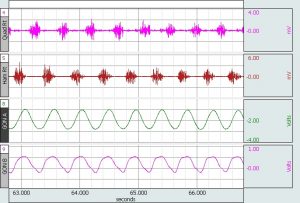New Citations | Heart Rate & Heart Rate Variability, Wingate Anaerobic Test, and Neuroscience of Music
 HRV, EMG, and EEG studies using BIOPAC hardware and software include:
HRV, EMG, and EEG studies using BIOPAC hardware and software include:
DON’T STRESS
Humans encounter various stressful situations everyday at work, home, and school. Such stress when experienced at high degrees and/or for a long duration of time could lead to cardiovascular diseases, cognitive dysfunctions, and psychological disorders. This study examined the validity of a novel physiological measurement technology called transdermal optical imaging (TOI) for assessing basal stress, and compared data from TOI against the pulse data collected from the BIOPAC MP150 System with ECG100C Amplifier. Findings revealed that TOI measurements of heart rate and heart rate variability (HRV), which reflects basal stress, corresponded strongly to those obtained from BIOPAC. Potential applications of this technology in psychological research and other fields are discussed. Read the full study: Transdermal Optical Imaging Reveal Basal Stress via Heart Rate Variability Analysis: A Novel Methodology Comparable to Electrocardiography (Jing Wei, Hong Luo, Si J. Wu, Paul P. Zheng, Genyue Fu, and Kang Lee).
PEDAL TO THE METAL
Anaerobic power is an important component in athletic performances such as in sprint running or sprint cycling and is commonly measured using the Wingate Anaerobic Test (WAnT). The WAnT is typically performed on a stationary cycle with the subject pedaling as fast as possible for 15 to 30 seconds against a pre-determined resistance or load. The purpose of this study was to determine if the addition of hip rotation can affect lower body anaerobic power during sprint cycling and to test methods for a larger study. Four untrained subjects performed a Wingate Anaerobic Test for 30 seconds using standard cycling technique (ST) on one day and on another day, subjects switched to hip rotation (RT) for the final 15 seconds. Subjects were fitted with electrodes, which were used to analyze electromyography (EMG) data using the BIOPAC MP36 Data Acquisition Unit. EMG data was analyzed between ST and RT at the four locations of electrode placements. The EMG data appeared to show differences in muscle activity that could be related to differences in muscle activation requirement between the RT and ST tests. Read the full study: EMG Analysis of Exaggerated Hip Rotation on Anaerobic Power During Sprint Cycling (Kayly Coleman, Clay Dixon, Gina Gonzalez, Manuel Probst).
MUSIC FOR THE SOUL
The neuroscience of music is the scientific study of brain-based mechanisms involved in the cognitive processes underlying music. The connection between the brain and music is robust and bidirectional. The objective of this study is to understand the changes in cerebral activity produced by learning a basic part of musical theory – the melodic intervals. Fifteen non-musicians without any academic theoretical musical knowledge were selected to participate voluntarily in this study. Using the electroencephalogram (EEG) as the acquiring method, cerebral activity was analyzed at two different moments, baseline and after a 5 day training period. The equipment used was the BIOPAC MP150 System with AcqKnowledge software and EEG100C Amplifier. The EEG task corresponded to recognize and identify the melodic intervals in display. Behavioral responses exposed an improvement on reaction time factor and accuracy. Conclusions: Cerebral activation, activity and frequencies in non-musicians who have acquired some theoretical musical knowledge exhibit visible differences in-between evaluations. Read the full study: Brain processing and coding responses to musical expertise: An EEG study (Vitória Silva, Telmo Pereira, Jorge Conde).
Stay Connected